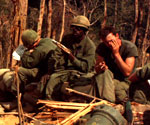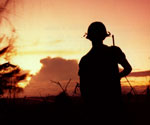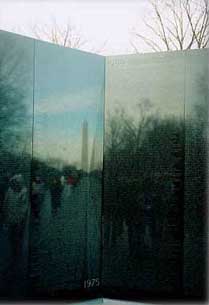|
Digital
History>eXplorations
Teacher
Resources
 |
 |
|
Members
of the 3rd Bn, 12th Inf, 4th Inf Div, "take five"
during bunker construction on Hill 530.
25 November 1967
US Army Center of Military
History |
PFC
John Sizemore, Co C, stands guard on Hill 742 as the sun sets
in the background.
14-17 November 1967
US Army Center of Military
History |
A
helicopter prepares for a resupply mission during an operation
conducted 20 miles southwest of Dak To.
10-16 December 1967
US Army Center of Military
History |
This
page contains specific resources developed for teachers using
this Exploration.
Entire
Unit | Where is Vietnam? | The
Decision To Escalate
The Antiwar Movement | My Lai Massacre | Negotiated Settlement
Public Opinion and the War | Lessons
of Vietnam
Photography and the War | Music
of the Vietnam Era
Focusing
Events for Entire Unit:
Vietnam
Veterans
The
experience of the many Americans in Vietnam offers a great way
to begin this unit. Vietnam Veterans of America (http://www.vva.org/)
offers many links on the experience of American soldiers in
Vietnam. You might also have Vietnam veterans come to your class
and discuss their experiences with the students.
If
you cannot have a veteran come to your classroom, then the Veterans
History Project at the Library of Congress provides first-hand
accounts.
http://www.loc.gov/folklife/vets/
 |
Vietnam
War Memorial
The
Vietnam War Memorial in Washington, DC is an excellent place
to begin discussion. Ask your students to comment on the
design, color, and shape of the monument.
Details
and pictures about the Vietnam War Memorial
Inquiry
questions:
- What
are the dates listed at the beginning and end of the Wall?
- Why
are these dates different from the official starting and
ending dates of the Vietnam War? (answers)
|
Resources
for the Wall and Other Memorials:
Unit
Resources:
- Vietnam:
A Television History
http://www.pbs.org/wgbh/amex/vietnam/
This is the Web site companion for the PBS series, "Vietnam:
A Television History." This website documents the conflict
that changed a generation and analyzes the costs and consequences
of this controversial war.
Site contents include:
- Who's
Who: Learn who the role players were in the war.
- Vietnam
Timeline: This timeline chronicles key history from
1945 to 1997.
- Reflections
on a War: Vietnamese and American survivors of the war
look back on their experiences.
- In
the Trenches: From weapons to the My Lai Massacre to
MIAs, learn more about the fighting in Vietnam.
Back
to Top
Exploration
1: Where is Vietnam?
Ask
students to locate Vietnam on a world map and identify major cities
and divisions.
Printable
map of Vietnam from the National Geographic Society
This
resource, found in the Xpeditions Atlas, is a printable map
of Vietnam. The maps available in the atlas allow the user to
choose basic or detailed view, turn borders on or off, and save
the map as a .pdf or .gif file.
http://www.nationalgeographic.com/xpeditions/
atlas/index.html?Parent=asia&Rootmap=vietna&Mode=d
Resources:
- Vietnam:
A Country Study
A wealth of information about Vietnam in this online version
of a handbook published by the Library of Congress. The handbook
presents a description and analysis of the historical setting
and the social, economic, and political issues.
http://lcweb2.loc.gov/frd/cs/vntoc.html
- An
Introduction to Vietnam
InterKnowledge Corp.'s description of Vietnamese geography,
climate, history, culture, and people.
http://www.interknowledge.com/vietnam/index.html
Back
to Top
Exploration
2: The Decision To Escalate
Use
the following resource to graph the escalation of troops in Vietnam.
Global
U.S. Troop Deployment, 1950-2003 by Tim Kane, Ph.D.
Center for Data Analysis Report #04-11
The
proposed global redeployment of U.S. troops coupled with the
open question of how long U.S. forces will stay in Iraq highlight
the need for objective data on force deployments, objectives,
and results. Surprisingly, no comprehensive time series data
on U.S. troop deployments by year and country seem to exist
in a single dataset. This report remedies that need by
introducing a comprehensive troop deployment dataset for 1950–2003.
The Troops dataset is available here:
http://www.heritage.org/Research/NationalSecurity/troopsdb.cfm
View
sample graphs for this dataset
Students
should read an article concerning the United States involvement
in Vietnam and should list the reasons given in each article for
escalation. These reasons should be used as a basis for discussion
about the 1965 escalation of the war. The students, having the
advantage of hindsight, should also examine whether President
Johnson was honest with the American public concerning the role
of these troops were to play in Vietnam.
1. US
orders 50,000 troops to Vietnam
2. “Johnson Orders 50,000 More Men to Vietnam and Doubles
Draft; Again Urges U. N. to Seek Peace,” New York Times,
29 July 1965.
3. “President Will Double Draft Call,” New Haven
Register, 29 July 1965.
Back
to Top
Exploration
3: The Antiwar Movement
Dr.
Martin Luther King was also a voice against the Vietnam
War. On April 4, 1967, King delivered a speech entitled "Beyond
Vietnam." King stated that the war effort was "taking
the young black men who have been crippled by our society and
sending them 13,000 miles away to guarantee liberties in Southeast
Asia which they had not found in southwest Georgia and East Harlem."
Back
to Top
Exploration
4: My Lai
Massacre
Use
the Photostory of the
My Lai Massacre by Michael Ray as an overview for this eXploration.
(Caution: This Photostory contains graphic photos and may not
be appropriate for younger audiences.)
What
is a Photostory? (this link opens in a new window; close
that window to return to this page)
Use
the questions found in The My Lai Courts-Martial: Questions
for Discussion by Doug Linder
http://www.law.umkc.edu/faculty/projects/ftrials/mylai/questions.html
Examples:
- How
do you explain what happened at My Lai?
- What
can be done to prevent such tragedies from happening again?
- What
does My Lai teach us about the nature of evil?
- Was
Calley evil, or was he a more-or-less “normal person
in abnormal circumstances”?
- Would
Calley have acted differently had he received more training
in the rules of warfare?
Back
to Top
Exploration
5: Negotiated
Settlement
Resources:
Back
to Top
Exploration
6: Public
Opinion and the War
 |
In
1968, Walter Cronkite was the anchor for
the CBS Evening News. The Vietnam War was raging and the American
public was deeply divided about U.S. involvement in Southeast
Asia. Cronkite went to Vietnam and brought back reports that,
some historians say, changed the U.S. public's attitude about
the war. |
President
Lyndon B. Johnson, watching the telecast, reportedly turned to
an aide and said, "If I've lost Cronkite, I've lost middle
America."
Resources:
- Recalling
the Vietnam War
This resource, from the University of California-Berkeley's
"Conversations with History" website, features video
interviews with key people involved in the Vietnam War.
http://conversations.berkeley.edu/search/node/vietnam
- The
Gallup Brain
This website is a searchable, living record of 70 years of public
opinion. This website allows users to search the questionaires
and responses used by the Gallup Poll for the past 70 years.
Users can enter keywords or search by decades for statistical
data.
http://institution.gallup.com/search/advanced.aspx
Back
to Top
Exploration
7: Lessons
of Vietnam
Back
to Top
Exploration
8: Photography
and the War
Tools
for analyzing photographs:
Lesson
Plans:
Resources
for more photographs of Vietnam:
Back
to Top
Exploration
9: Music
of the Vietnam Era
Resources:
Connecting
to Poetry
Back
to Top
|
